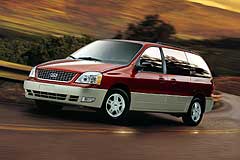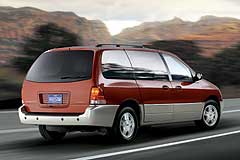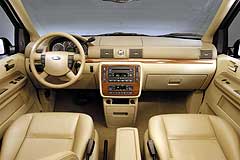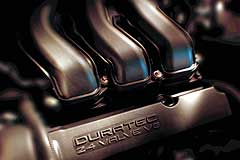The 2004 Ford Freestar minivan

Base MSRP Range: $21,385 - $32,945
Base Invoice Range: $19,488- $29,776
MSRP As Tested: Not Available
Versions: S, SE, SES, SEL and Limited
Vehicle Category: Minivan
Engine Location: Front Engine
Drive Wheels: Front-Wheel Drive
Engine As Tested: 4.2-liter, Overhead Cam, 24-valves, V-6 cylinder, 201-horsepower at 4,250rpm and 263 lb-ft torque at 3,650 rpm.
Standard Engine: 3.9-liter, Overhead Cam, 24-valves, V-6 cylinder, 193-horsepower at 4,750rpm and 240 lb-ft torque at 3,750 rpm.
Transmission As Tested: Standard 4-Speed, Automatic.
Fuel Economy (city/hwy): 3.9L 17/23, 4.2L 16/22
Standard Safety Features: Driver and front passenger airbags, power-assisted disc brakes, ">Antilock Braking System (ABS).
Competition: Chevrolet Venture, Nissan Quest, Mazda MPV, Kia Sedona, Toyota Sienna, Pontiac Montana, Dodge Caravan, Chrysler Town & Country, Mercury Monterey.
Review
Traverse City, Michigan - The roads outside of Traverse City are wonderful for test drives. The countryside is magnificent, green, and uniquely spectacular for early fall drives when the days are still hot, and long, but not humid. To locals, I suppose, that forewarns of snow and winter weather. But for us it provided several, carefree days to focus on the new Ford Freestar.
And new, this product is. But it needed to be. The Freestar's predecessor, the Windstar, was a step up in minivan design for Ford. But despite great safety ratings the vehicle was noisy and owners felt the build quality did not live up to Ford's promise. In order for Ford to succeed with the next-generation of the "family workhorse" minivan they needed to compete with the Toyota Sienna and Honda Odyssy for build quality. As it takes a long time to loose a bad reputation it was critical that the new minivan be significantly better than its predecessor.
In the interim Nissan introduced the new Quest. Quest is a spectacular van that is sure to give all minivans a run for their money. Freestar has not only the reputation of Toyota and Honda to contend with, but now Quest is the style leader.
Freestar is an apt competitor for styling. It is certainly better than Honda, or Toyota. It would appear that Freestar also competes with these products for quality. Only time will tell if the product holds up, but our first impression was a good one.
The interior of the Freestar is quiet, quiet, quiet. There are none of the rattles and squeaks that Windstar had. But Freestar remains noisy outside - beware neighbors!
Perhaps the most important thing we can say about Freestar is; the two days of driving in the van were carefree. It had all the power we needed to get up and down hills with the air conditioning on full blast and four good sized adults on board. The 4.2 liter engine is probably a necessary purchase if you ever plan to drive the car loaded with people and stuff, and have the air conditioning on - such as on a long family driving vacation. But the 3.9 liter engine performed well enough with the A/C on, and four adults on board. We had no luggage to speak. For common use the smaller engine should be sufficient. But if you haul lots of stuff, opt for the larger.
If the quietness, standard features and pricing meet with your quality expectations - and they did our's -- then you are sure to be delighted by the accessories Ford has dreamed up to add comfort and functionality to the vehicle.
Our biggest complaint with the Freestar is gas mileage - a complaint we have with all vehicles - but Ford promised to improve it more quickly than they have. We still want them to live up to the promise.
Vehicle History
Ford minivans are one of the staples of the company's product line, though they certainly have bigger selling products like the F-150 pickup truck.
It's hard to say which product in Ford's line was their first minivan, but by the 1980s the Aerostar was clearly in that category. Following that Ford introduced the Windstar, a larger and more spacious product. The Freestar replaces the Windstar to a good extent, and brings new technology and current chassis design for a much needed updating. The improvements are vast.
Freestar, as was the Windstar, is built in Ontario, Canada and is thus not a "made in the USA" product.
Changes Over the Previous ModelThe most noticeable change for us was the sound of the van when you are inside it. There wasn't much. Gone are the squeaks and rattles of its predecessor -- replaced with a conversation-conducing quiet.
It is also more spacious and has important family-friendly features like easy-to-tilt-forward second-row seats, a fold-flat rear seat, and passenger seat cupholders that don't break off when stepped on - a common occurrence when the kids get in and out of vans.
Perhaps the most interesting change is Ford's continuing march toward improved product quality. We do believe every product they make is significantly better built than its predecessor. Ford is listening to the consumers and making appropriate changes.
A new 4.2 liter, V6 engine has been introduced as an option along with the standard 3.9 liter, V6.
Freestar has 4-wheel disc brakes, something a minivan should never be without. An Antilock Braking System (ABS) is now a standard feature.
Ford has introduced an optional Panic Brake Assist system which is combined with AdvanceTrac, their stability enhancement system.
Next they need to make their vehicles more fuel efficient, get the hybrids on the market and make the products quieter on the outside.

Vehicle Exterior
We'll say it right up front, "don't get the version with the cladding, the ones without it look great." There, we said it. But then we say this about most vehicles.
Freestar's simple nose and hood begin with a grid patterned grill and the Ford Blue Oval logo. The hood is long which gives it a streamlined and modern look. The angle of the windshield is small, not so much so that it makes the roof line round, but just enough to distinguish it from a pickup truck or SUV. The A-pillar (front support) is thin for both better visibility, and design.
The van's shoulder line, from front to back, is flat and there are fewer body panels making the exterior design calm. The designers also made the side windows appear contiguous; it almost looks like one large window, rather than three small ones.
The rear cargo door is uncomplicated and practical. The door opens smoothly, and it is easy to close. The rear window is large for good visibility and has an attractive scoop shape. It's a very nice looking van.
Vehicle Interior
No doubt the people who designed the Freestar used minivans themselves. They solved a lot of problems that owners experience, like cup holders that break when children accidentally step on them. Freestar's doesn't do that - even when an adult steps on them, so they are grandma proof to. This saves money as a replacement cup holder costs a small fortune!
Freestar has everything it needs on the dash and nothing that it doesn't. Two large, round gauges, one for the speedometer and another for the RPMs flank two smaller ones for fuel and temperature. Below them is a digital read out that includes information such as miles before fill-up, time, direction and temperature.
In the center, top of the dash, there is a storage compartment with a latching lid. In go the pens, pads, gum packs, maps, house-keys and cell phone. The latch secures the compartment and keeps all those objects from wandering around the passenger compartment. Below it are the front air vents, followed by the audio controls and those for the DVD system, if you buy it. There is an optional center console which is large enough to hold a small handbag, computer, a large day minder, or a good number of file folders.
Two fun, standard features are a child-view mirror (one that is convex allowing you to see what all your passengers are up to) and water bottle holders in the doors - Ford realized Moms don't drink from juice boxes very often and needed the appropriate beverage holder.
There is nothing special about the quality of the dash, seat, headliner, door panel or floor covering materials. But most importantly, they look like they will be easy to clean. We're up for easy since the minivan is generally the family workhorse and needs a good cleaning from time to time .
Freestars equipped with 2nd and 3rd row bench seats get a flat load floor: meaning both benches fold flat into the floor without needing to be removed. A stellar feature.
Behind the 3rd row seat there is a deep well. It is perfect for holding bags of groceries upright. But there is another reason for it. If you fill it with items, like cases of bottled water, the seat can still be rotated backwards. This provides a rear-facing bench seat that can be used when the vehicle is parked and the liftgate open. It makes a cozy spot to climb into to watch a sunset, or a child's ballgame. And you don't have to remove the headrests! Instead, the same headrests have be designed as footrests for use when the seat is reversed.
Back-up sensors are optional. And they are an option that we like more and more. The older we get, the harder it is to turn around and we like this feature in almost every car we drive, that has it.

Performance
Freestar is available with two engine options. It comes standard with a 3.9 liter V-6 engine that generates 193 horsepower at 4,750 RPMs, and 240 lb-ft of torque at 3,750 RPMs .
The optional 4.2 liter V6 is all new. It generates 201 horsepower at 4,250 RPMs and 263 lb. ft. of torque at 3,650 RPM.
We found that while the 3.9 liter engine provided plenty of power for a van filled with 4 adults and the air conditioning turned on, the 4.2 liter was more fun for an outing. Having the extra horsepower and torque will make a big difference when the van is loaded for a vacation, or pulling a boat.
Both engines have received the ULEV (Ultra-Low Emissions) classification. This is by no means the cleanest rating, but it is a big improvement.
Both engines come with a fail-safe cooling system. This is a new Ford feature for 2004. This feature enables Freestar to be driven a short distance after the engine coolant is gone - such as when a hose breaks.
If you've driven the Windstar you'll find a notable difference in how smoothly the new 4-speed automatic transmission changes gears. You can barely hear or feel it happen when you are riding in the car.
Ride and Handling
To be honest with you, we didn't drive the Freestar much because Sandra recently had surgery on her right hand. Instead she spent a great deal of time being a passenger. Regardless of where in the vehicle she sat though, she experienced a smooth, quiet, comfortable ride.
Our only complaint is that the front seats are a bit too tall. Sandra is only 5' 3" and the seat felt as if it were tightly pressed against the back of her legs. This wasn't a problem for people who were taller. Otherwise the seats are comfortable and not fatiguing despite that we put a lot of miles on the vehicle.
The handling was as good as any other minivan we have driven, except perhaps for the Quest. But it's close. There wasn't extra play in the steering and the car went where we expected it to when swerving quickly, right or left. It felt quite stable on long, wide, fast curves - not a sports sedan, but enough so that it would be fun on winding mountain roads.
Safety
Ford's Personal Safety System is standard. This is their way of discussing the various restraint technologies that protect you in a crash while adjusting to the severity of the crash and the occupants. They expect the truck to do well in the NCAP and IIHS crash tests, as did its predecessor the Windstar.
Safety belt use and seat position sensors determine the extent of front and side airbag deployment for the driver. For the front-passenger a single weight sensor determines deployment. From what we can tell, there are no airbags protecting the second row seats unless you purchase the optional Safety Canopy side curtain airbag system. This airbag curtain has a rollover sensor and also includes a reinforced structure designed for offset front impacts.
There are also three-point seatbelts for every seating position in the minivan. And the vehicle contains all the federally mandated safety features like the child safety seat LATCH system, etc.
Another feature we like are the power adjustable pedals. Given that the seating position of the driver is critical to all passengers' safety it is important that drivers be able to make every possible adjustment. The power adjustable pedals enable the driver to sit comfortably while also being the proper distance from the airbag. This is a good feature that should be standard on all cars and trucks sold to consumers.
In Conclusion
The Ford Freestar is a vast improvement over its predecessor the Windstar. It is quiet on the inside, loaded with great features like the tilt back 3rd row seat, 2 fold-flat rows of seats, 4-wheel disc brakes with ABS, nearly unbreakable cupholders, water bottle holders and loads, and loads, and loads of storage compartments.
While the interior isn't luxurious, it is a workhorse. And the Freestar's sister the Mercury Monterey provides all the luxury needed, if a fancy interior is on the shopping list.
Freestar looks as good as any competitor and handles and rides just as well. It appears to have better build quality than the Chrysler and Dodge products and more style than the products from GM, Toyota or Honda. The only product that might beat it, is the Nissan Quest. However they are different products and need to be test driven.
Editors' Ratings
Pros: Ford has improved the quietness of the Freestar and eliminated the annoying squeaks and rattles. The ride and handling are as good as any competitively priced minivan on the market. The standard product is filled with excellent features and the range of accessories is mind-boggling.
Cons: Ford doesn't have consumers' trust when it comes to long-term reliability. They are making improvements though and every product they produce comes closer to the mark. Gas mileage needs to be better as does that of all minivans.
Ratings (1-10)
- Style: 6
- Performance: 7
- Price: 6
- Handling: 7
- Ride: 7
- Comfort: 8
- Quality: 7
- Overall: 6.86
More Data
Where Built: Oakville, Ontario, Canada.
Major Options: Rear Obstacle Detection System and tons of other stuff too numerous to list here.
Seating: 7 or 8
Number of Rows: 3
Length in Inches: 201
Warranties: 3-years/36,000-mile bumper-to-bumper, 5 years/unlimited mileage corrosion, 3 years/36,000 roadside assistance.
Weight in Pounds: 4,275.
Maximum Payload in Pounds: Not Available.
Maximum Gross Vehicle Weigh in Pounds: Not Available.
Towing Capacity in Pounds: 2,000.
Gas Tank Capacity in Gallons: 26.
Destination Charge: $685




